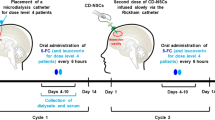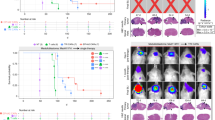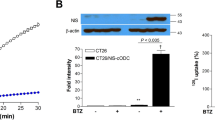Abstract
Medulloblastoma is a heterogeneous diffuse neoplasm that can be highly disseminated, and is the most common malignant childhood brain tumor. Although multimodal treatments have improved survival rates for patients with medulloblastoma, these tumors are associated with high morbidity and mortality. New treatment strategies are urgently needed to improve cure rates and, importantly, to spare normal brain tissue from neurotoxicity and patients from life-long cognitive and functional deficits associated with current therapies. In numerous preclinical brain tumor models, neural stem cells (NSCs) have shown great promise as delivery vehicles for therapeutic genes. Here, we have used an established, genetically modified human NSC line (HB1.F3.CD) to deliver carboxylesterase (CE) to cerebellar tumor foci and locally activate the prodrug camptothecin-11 (CPT-11) (Irinotecan) to the potent topoisomerase I inhibitor SN-38. HB1.F3.CD NSC tumor tropism, intratumoral distribution and therapeutic efficacy were investigated in clinically relevant experimental models. Magnetic resonance imaging was used for in vivo tracking of iron nanoparticle-labeled NSCs, and to assess the therapeutic efficacy of CE-expressing HB1.F3.CD cells. As compared with controls, a significant decrease in tumor growth rate was seen in mice that received both NSCs and CPT-11 as their treatment regimen. Thus, this study provides proof-of-concept for NSC-mediated CE/CPT-11 treatment of medulloblastoma, and serves as a foundation for further studies toward potential clinical application.
This is a preview of subscription content, access via your institution
Access options
Subscribe to this journal
Receive 12 print issues and online access
$259.00 per year
only $21.58 per issue
Buy this article
- Purchase on Springer Link
- Instant access to full article PDF
Prices may be subject to local taxes which are calculated during checkout





Similar content being viewed by others
References
Ellison DW . Childhood medulloblastoma: novel approaches to the classification of a heterogeneous disease. Acta Neuropathol 2010; 120: 305–316.
Dubuc AM, Northcott PA, Mack S, Witt H, Pfister S, Taylor MD . The genetics of pediatric brain tumors. Curr Neurol Neurosci Rep 2010; 10: 215–223.
Hatten ME, Roussel MF . Development and cancer of the cerebellum. Trends Neurosci 2011; 34: 134–142.
Ginstfeldt T, Emanuelson I . An overview of attention deficits after paediatric traumatic brain injury. Brain Inj 2010; 24: 1123–1134.
Roussel MF, Hatten ME . Cerebellum development and medulloblastoma. Curr Top Dev Biol 2011; 94: 235–282.
Aboody KS, Najbauer J, Danks MK . Stem and progenitor cell-mediated tumor selective gene therapy. Gene Therapy 2008; 15: 739–752.
Kim SK, Kim SU, Park IH, Bang JH, Aboody KS, Wang KC et al. Human neural stem cells target experimental intracranial medulloblastoma and deliver a therapeutic gene leading to tumor regression. Clin Cancer Res 2006; 12: 5550–5556.
Gutova M, Najbauer J, Frank RT, Kendall SE, Gevorgyan A, Metz MZ et al. Urokinase plasminogen activator and urokinase plasminogen activator receptor mediate human stem cell tropism to malignant solid tumors. Stem Cells 2008; 26: 1406–1413.
Brown AB, Yang W, Schmidt NO, Carroll R, Leishear KK, Rainov NG et al. Intravascular delivery of neural stem cell lines to target intracranial and extracranial tumors of neural and non-neural origin. Hum Gene Ther 2003; 14: 1777–1785.
Pommier Y . Topoisomerase I inhibitors: camptothecins and beyond. Nat Rev Cancer 2006; 6: 789–802.
Danks MK, Yoon KJ, Bush RA, Remack JS, Wierdl M, Tsurkan L et al. Tumor-targeted enzyme/prodrug therapy mediates long-term disease-free survival of mice bearing disseminated neuroblastoma. Cancer Res 2007; 67: 22–25.
Aboody KS, Bush RA, Garcia E, Metz MZ, Najbauer J, Justus KA et al. Development of a tumor-selective approach to treat metastatic cancer. PLoS One 2006; 1: e23.
Arbab AS, Pandit SD, Anderson SA, Yocum GT, Bur M, Frenkel V et al. Magnetic resonance imaging and confocal microscopy studies of magnetically labeled endothelial progenitor cells trafficking to sites of tumor angiogenesis. Stem Cells 2006; 24: 671–678.
Arbab AS, Janic B, Knight RA, Anderson SA, Pawelczyk E, Rad AM et al. Detection of migration of locally implanted AC133+ stem cells by cellular magnetic resonance imaging with histological findings. FASEB J 2008; 22: 3234–3246.
Thu MS, Najbauer J, Kendall SE, Harutyunyan I, Sangalang N, Gutova M et al. Iron labeling and pre-clinical MRI visualization of therapeutic human neural stem cells in a murine glioma model. PLoS One 2009; 4: e7218.
Ranger A, McDonald W, Moore E, Delmaestro R . The invasiveness of five medulloblastoma cell lines in collagen gels. J Neurooncol 2010; 96: 181–189.
Arbab AS, Wilson LB, Ashari P, Jordan EK, Lewis BK, Frank JA . A model of lysosomal metabolism of dextran coated superparamagnetic iron oxide (SPIO) nanoparticles: implications for cellular magnetic resonance imaging. NMR Biomed 2005; 18: 383–389.
Packer RJ, Vezina G . Management of and prognosis with medulloblastoma: therapy at a crossroads. Arch Neurol 2008; 65: 1419–1424.
Vassal G, Boland I, Santos A, Bissery MC, Terrier-Lacombe MJ, Morizet J et al. Potent therapeutic activity of irinotecan (CPT-11) and its schedule dependency in medulloblastoma xenografts in nude mice. Int J Cancer 1997; 73: 156–163.
Turner CD, Gururangan S, Eastwood J, Bottom K, Watral M, Beason R et al. Phase II study of irinotecan (CPT-11) in children with high-risk malignant brain tumors: the Duke experience. Neuro Oncol 2002; 4: 102–108.
Bomgaars LR, Bernstein M, Krailo M, Kadota R, Das S, Chen Z et al. Phase II trial of irinotecan in children with refractory solid tumors: a Children's Oncology Group Study. J Clin Oncol 2007; 25: 4622–4627.
Gutova M, Najbauer J, Chen MY, Potter PM, Kim SU, Aboody KS . Therapeutic targeting of melanoma cells using neural stem cells expressing carboxylesterase, a CPT-11 activating enzyme. Curr Stem Cell Res Ther 2010; 5: 273–276.
Aboody K, Capela A, Niazi N, Stern JH, Temple S . Translating stem cell studies to the clinic for CNS repair: current state of the art and the need for a Rosetta Stone. Neuron 2011; 70: 597–613.
Frank RT, Edmiston M, Kendall SE, Najbauer J, Cheung CW, Kassa T et al. Neural stem cells as a novel platform for tumor-specific delivery of therapeutic antibodies. PLoS One 2009; 4: e8314.
Aboody KS, Najbauer J, Schmidt NO, Yang W, Wu JK, Zhuge Y et al. Targeting of melanoma brain metastases using engineered neural stem/progenitor cells. Neuro Oncol 2006; 8: 119–126.
Aboody KS, Brown A, Rainov NG, Bower KA, Liu S, Yang W et al. Neural stem cells display extensive tropism for pathology in adult brain: evidence from intracranial gliomas. Proc Natl Acad Sci USA 2000; 97: 12846–12851.
Zhao D, Najbauer J, Garcia E, Metz MZ, Gutova M, Glackin CA et al. Neural stem cell tropism to glioma: critical role of tumor hypoxia. Mol Cancer Res 2008; 6: 1819–1829.
Gibson P, Tong Y, Robinson G, Thompson MC, Currle DS, Eden C et al. Subtypes of medulloblastoma have distinct developmental origins. Nature 2010; 468: 1095–1099.
Read TA, Fogarty MP, Markant SL, McLendon RE, Wei Z, Ellison DW et al. Identification of CD15 as a marker for tumor-propagating cells in a mouse model of medulloblastoma. Cancer Cell 2009; 15: 135–147.
Gilad AA, Walczak P, McMahon MT, Na HB, Lee JH, An K et al. MR tracking of transplanted cells with ‘positive contrast’ using manganese oxide nanoparticles. Magn Reson Med 2008; 60: 1–7.
Artemov D, Mori N, Okollie B, Bhujwalla ZM . MR molecular imaging of the Her-2/neu receptor in breast cancer cells using targeted iron oxide nanoparticles. Magn Reson Med 2003; 49: 403–408.
Wu X, Hu J, Zhou L, Mao Y, Yang B, Gao L et al. In vivo tracking of superparamagnetic iron oxide nanoparticle-labeled mesenchymal stem cell tropism to malignant gliomas using magnetic resonance imaging. Laboratory investigation. J Neurosurg 2008; 108: 320–329.
Neuwelt EA, Varallyay CG, Manninger S, Solymosi D, Haluska M, Hunt MA et al. The potential of ferumoxytol nanoparticle magnetic resonance imaging, perfusion, and angiography in central nervous system malignancy: a pilot study. Neurosurgery 2007; 60: 601–611; discussion 611–602.
Lim SH, Choi SA, Lee JY, Wang KC, Phi JH, Lee DH et al. Therapeutic targeting of subdural medulloblastomas using human neural stem cells expressing carboxylesterase. Cancer Gene Ther 2011; 18: 817–824.
Flax JD, Aurora S, Yang C, Simonin C, Wills AM, Billinghurst LL et al. Engraftable human neural stem cells respond to developmental cues, replace neurons, and express foreign genes. Nat Biotechnol 1998; 16: 1033–1039.
Potter PM, Wolverton JS, Morton CL, Wierdl M, Danks MK . Cellular localization domains of a rabbit and a human carboxylesterase: influence on irinotecan (CPT-11) metabolism by the rabbit enzyme. Cancer Res 1998; 58: 3627–3632.
Wierdl M, Morton CL, Weeks JK, Danks MK, Harris LC, Potter PM . Sensitization of human tumor cells to CPT-11 via adenoviral-mediated delivery of a rabbit liver carboxylesterase. Cancer Res 2001; 61: 5078–5082.
Orsulic S . An RCAS-TVA-based approach to designer mouse models. Mamm Genome 2002; 13: 543–547.
Team RDC . R Language and Environment for Statistical Computing. R Foundation for Statistical Computing: Vienna, Austria (http://www.R-project.org), 2011.
Pinheiro JC, Bates DM . Mixed effects models in S and S-plus. Springer: New York, 2000.
Acknowledgements
We are grateful to Dr Keely L Walker (City of Hope) for critical reading and editing of the manuscript. We also thank Dr Rolando F Del Maestro (McGill University, Montreal, Canada) for providing the UW228 primary medulloblastoma cell line. We are grateful to the USC/CHLA Small Animal Imaging Core for assistance with animal studies and MR imaging, and Dr Philip Potter (St Jude Children's Research Hospital, Memphis, TN) for providing the rCE adenoviral vector. This work was supported with funds from the ThinkCure Foundation, California Institute of Regernerative Medicine DR1-01421, The Jean Perkins Foundation, The TJ Martell Foundation, the Rosalinde and Arthur Gilbert Foundation, the National Cancer Institute (Grant number P30 CA33572) and the Stop Cancer Foundation.
Author information
Authors and Affiliations
Corresponding authors
Ethics declarations
Competing interests
KSA, AJA are founders, CSO and COO (respectively) of TheraBiologics, Inc., a clinical stage biopharmaceutical company supporting development of NSC-mediated cancer treatments. The remaining authors declare no conflict of interest.
Additional information
Supplementary Information accompanies the paper on Gene Therapy website
Rights and permissions
About this article
Cite this article
Gutova, M., Shackleford, G., Khankaldyyan, V. et al. Neural stem cell-mediated CE/CPT-11 enzyme/prodrug therapy in transgenic mouse model of intracerebellar medulloblastoma. Gene Ther 20, 143–150 (2013). https://doi.org/10.1038/gt.2012.12
Received:
Accepted:
Published:
Issue Date:
DOI: https://doi.org/10.1038/gt.2012.12
Keywords
This article is cited by
-
Analysis of glioblastoma tumor coverage by oncolytic virus-loaded neural stem cells using MRI-based tracking and histological reconstruction
Cancer Gene Therapy (2015)
-
Stem cell-based therapies for cancer treatment: separating hope from hype
Nature Reviews Cancer (2014)
-
Long-term efficiency of mesenchymal stromal cell-mediated CD-MSC/5FC therapy in human melanoma xenograft model
Gene Therapy (2014)
-
Double suicide gene therapy using human neural stem cells against glioblastoma: double safety measures
Journal of Neuro-Oncology (2014)



